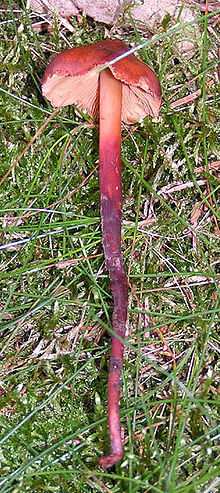
Back فايكوليبيا ARZ Phaeocollybia CEB Wurzelschnitzlinge German Phaeocollybia Spanish Juurkõrges ET Ruostejuurekkaat Finnish Phaeocollybia Dutch Phaeocollybia Polish Phaeocollybia Swedish Phaeocollybia WAR
| Phaeocollybia | |
|---|---|

| |
| Phaeocollybia jennyae | |
| Scientific classification | |
| Kingdom: | |
| Division: | |
| Class: | |
| Order: | |
| Family: | |
| Genus: | Phaeocollybia R.Heim (1931)
|
| Type species | |
| Phaeocollybia lugubris (Fr.) R.Heim (1931)
| |
| Synonyms[1] | |
|
Quercella Velen. (1921) nom. rej. | |
Phaeocollybia is a genus of fungi in the family Hymenogastraceae.[2] They are characterized by producing fruit bodies (mushrooms) with umbonate caps and rough brown spores. The genus is widely distributed (especially in temperate regions), and contains about 50 species.[3] They are known for a long stipe which continues down into the ground, known as a rooting stipe or pseudorhiza formed as the fruitbody grows up from the subterranean colonized roots well below the organic soil layer. The genus is primarily mycorrhizal but may also be somewhat parasitic on forest trees.[4]
Molecular phylogenetic work during the 2000s suggests a close relationship to Galerina.
- ^ Cite error: The named reference
urlMycoBank: Phaeocollybiawas invoked but never defined (see the help page). - ^ Cite error: The named reference
Matheny 2006was invoked but never defined (see the help page). - ^ Cite error: The named reference
Kirk2008was invoked but never defined (see the help page). - ^ Norvell, L.L.; Exeter, R.L. (2008). Phaeocollybia of Pacific Northwest North America. U.S. Dept. of the Interior, Bureau of Land Management, Salem District. pp. 1–227. ISBN 978-0-9791310-1-1.